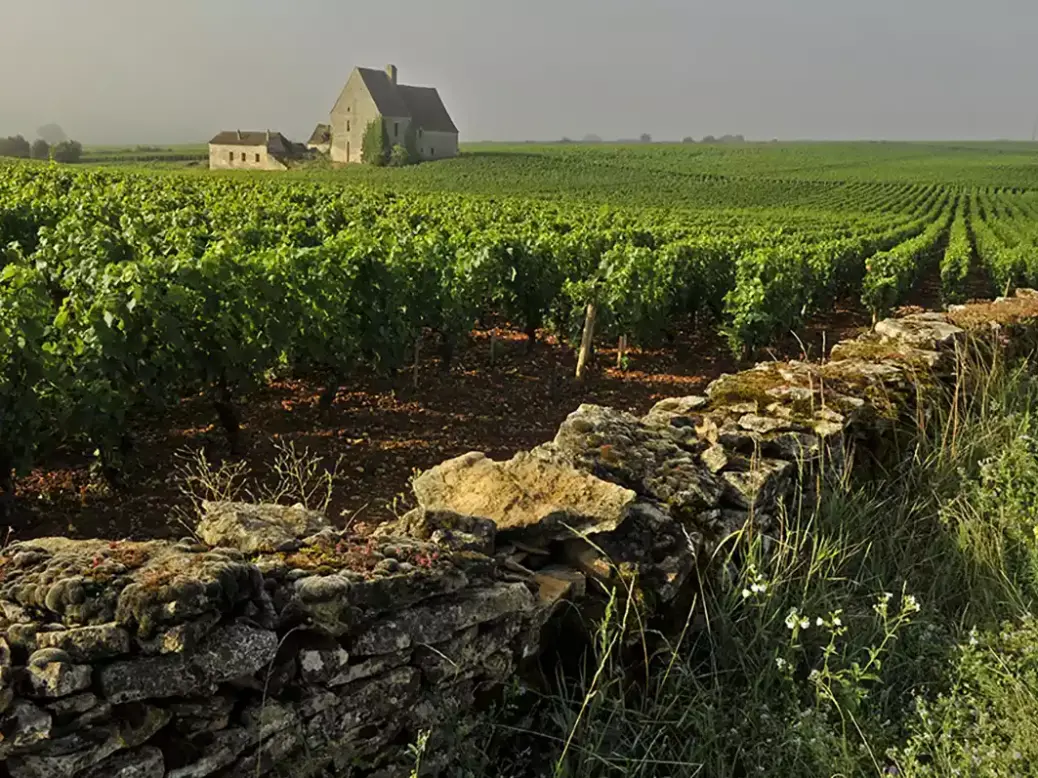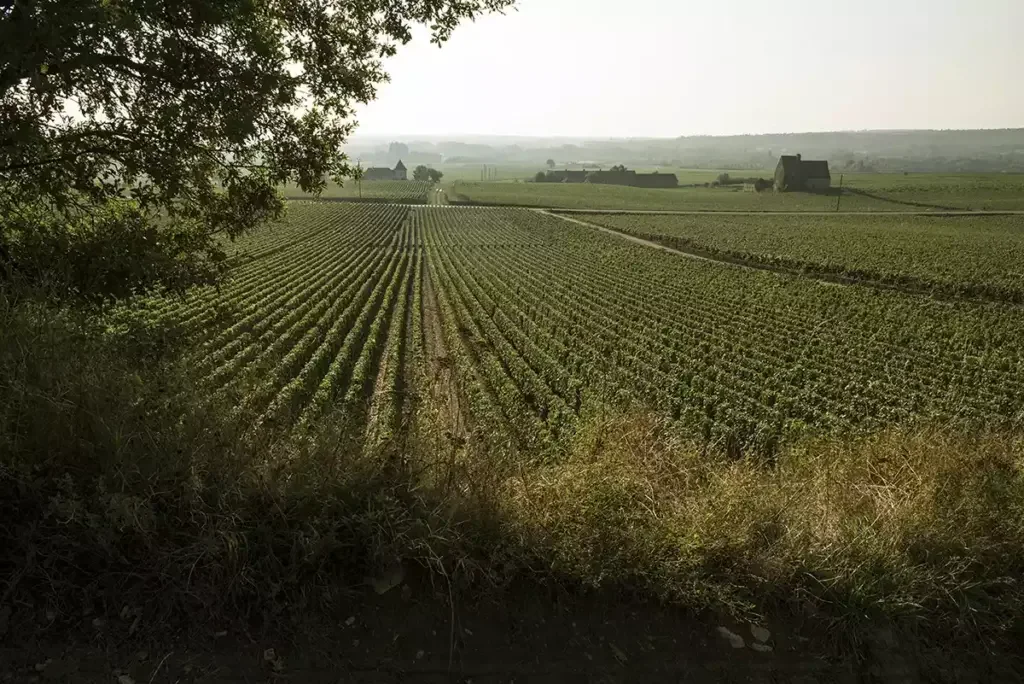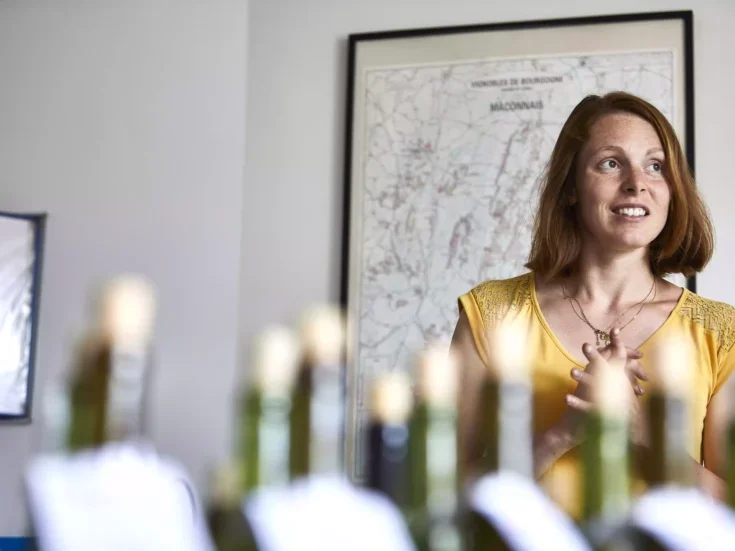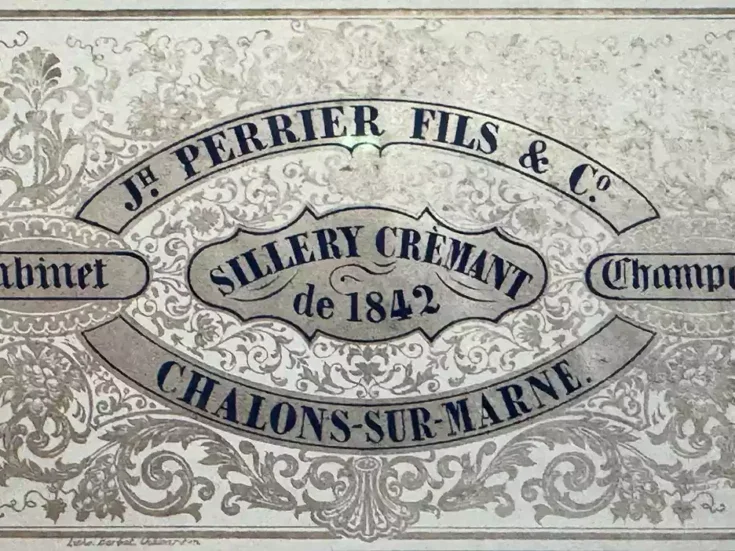
Sarah Marsh MW mulls over the diversity and aging capacity of Morgeot in the company of Jean-Baptise Bachelet with a vertical of Domaine Jean-Claude Bachelet et Fils, Chassagne-Montrachet Premier Cru, La Boudriotte.
A vertical tasting is always a pleasure, offering an insight into how vintages evolve. While there is much to be said for joyful, youthful fruitiness, I love the patina of age with its complex savory aromas and would always encourage some aging of Burgundy, especially white Burgundy, which can pass through a cellar with unseemly haste.
Often when I gather bottles for a vintage retrospective Chassagne producers put forward a wine from the premier cru Morgeot of which La Boudriotte is part. This extensive premier cru produces the most full-bodied and sturdiest of Chassagne’s premier cru whites. Not the finest expression of Chassagne I grant you, even a bit lumpen in youth, but Morgeot has the capacity to age which can generally be relied upon. A good one should have density, muscle, and staying power.
But I generalize for Morgeot is a premier cru of nearly 60ha (150 acres) which encompasses a broad span of land on the southern side of the village and is made up of 19 lieux-dits. So, let’s be specific for the soil in this large appellation is very varied and it makes perfect sense to be divided into smaller climats according to soil type, drainage, and place on the slope.
The heavier clays at the bottom turn out the fullest wines including most of Chassagne’s reds. I doubt that anyone would dispute the finest parcels lie in the upper section of this appellation, above the road which cuts through the lower part of the village. Here the soil is white marl mixed with stones.
This section includes Tête du Clos (Vincent Dancer and Ben Leroux, from a parcel just below La Romanée) and Les Petits Clos (Jean-Noël Gagnard). The effect of limestone in the clay produces wines of tension, focus, and channelled structure, stylistically somewhere between the broad muscular typicité of Morgeot and the elegance and raciness of the upslope premiers crus Grandes Ruchottes and La Romanée.
In the Morgeot lieux-dits of Les Fairendes and Les Petites Fairendes, a combination of more white with some red soils strikes a lighter, fresher balance in the wine than classic Morgeot. The top section below Les Ruchottes is the best section on whiter soils and Michel Morey-Coffinet makes an elegant, fluid version which he labels Les Farendes.
La Boudriotte lies just below the road, but also has a white marl. It’s a small lieu-dit of 2.22ha (5.4 acres), but just to confuse things another five lieux-dits may also be labelled as Boudriotte bringing the full Boudriotte ensemble to nearly 16ha (40 acres). This bunch includes Les Fairendes and Petites Fairendes and La Roquemaure which makes sense in terms of the soil, whereas Les Chaumes and Champs Jendreau are in heavier red clay.
Jean-Marc Blain-Gagnard has an old aerial photo on the wall of his cellar where it’s possible to see the change in soil from the whiter soil to the darker soil below. He has a long strip through this section of Morgeot, the top two thirds of which is clearly visible as white soil. His Boudriotte cuvée is always straighter and more instantly energetic than his fuller-bodied Morgeot cuvée.
So, some producers, Bruno Colin and Fontaine-Gagnard among them, produce a Boudriotte to distinguish it from another cuvée labelled Morgeot. Others use the Boudriotte name because they believe for consumers it has more cachet than Morgeot.
Jean-Claude Bachelet’s Boudriotte is actually from the small 2.69ha (6.7 acres) lieu-dit of Les Chaumes, which lies below Boudriotte proper in red clay soil. Jean-Noël Gagnard’s Boudriotte is also from here. Many years ago, I recall Caroline Lestimé telling me her father used to put it in a Morgeot cuvée, but she decided to separate the more limestone parcel of Petits Clos, from the flatter clay of Les Chaumes into two distinctive cuvées.
Jean-Baptiste describes Les Chaumes as “not closed or sheltered, but very open. It is a cold place in winter and in spring it is vulnerable to frost, as the cold air and frost collect here. However, because it is open it is quite warm in the summer. There is no effect from the combe, so it ripens quite early.
“We have adjacent parcels of Pinot and Chardonnay on exactly the same terroir. Often, I hear people say the soils in Morgeot are good for reds like Nuits-Saint-Georges, but I think they are good for both colors. If I replanted, I would keep both red and white. The white parcel is not an historic place for us. We’ve had red here for a long time, but in 2004 we had the opportunity to buy a parcel of white.”
“It’s on a very light slope, but this is sufficient to drain water. The soil is richer compared with the thin, white clay soil of Blanchots,” (where Bachelet also have vines). “The clay is darker here.”
Organic evolution
I was interested in how Bachelet has developed his approach in the vineyard and winery since he acquired the Boudriotte. For the past 20 years there have been no chemical herbicides used at the domaine and since 2012 he has been working organically and sprays earlier. He explains that “it is not just about the chemicals, but the way we think about the plant, helping it to protect itself. Organic culture is a healthier approach for the vines, for us working in the vineyards, and for the result in the bottle.”
The domaine will be certified as organic this year. “We were not interested in getting the certification but now we realize it’s the only way to prove that we really are telling the truth.” He expresses his exasperation with producers who trade on organic credentials, but use systemic chemicals when conditions are challenging and has decided it’s important to support a “collective identity” of producers who are committed to an organic approach. “It shows that you can do this even when the season is difficult. If you do your job.”
“We have a responsibility to do this especially as our (Burgundy) wines are so expensive,” he says. “So many producers in the South of France are certified organic and they are selling their wines for €10. In Burgundy we may be selling wine for €200 or €300. At this level we should be able to take risks.”
Prior to purchasing the Boudriotte parcel of Chardonnay, it was cultivated differently to Bachelet’s Pinot Noir section. “The roots were on the surface because of the culture, so we have worked the soil,” and Bachelet has seen the improvement over the intervening years. “The ploughing has helped with drainage. It is a deep soil, so it is really important to push the roots down so that the wine is not heavy.”
“It helps that the vines are 65 years old. There is always good balance in Boudriotte. We always get good maturation. It is not as precocious as Bienvenues and Puligny-Montrachet, Les Enseignères (other climatsowned by the domaine) but the pH of the grapes increases quickly so we have to take care.”
In the winery there have been few changes. By 2004 Bachelet had already moved to longer oak maturation; a year in barriques followed by four to five months in stainless steel for all the wines at the domaine. “The wines are treated the same from regional to grand cru.” He stopped fining ten years ago when fining trials showed it was unnecessary, after a long winter in tank. He lightly filters.
But most interesting are his observations on pressing, phenolics, and the potential aging capacity of whites. He had also already extended his press cycle to two hours and fifteen minutes. “It’s very gentle and we get fine lees so we can use everything. There is no need to separate the lees and I think using all of them is important. The end of the press is more phenolic and we need that in the wines for ageing. In reds we get tannins from the skin and in whites we need some phenolics too.”
“This is why the work in the vineyard is so important. It is much more difficult to get this good phenolic note for whites than for reds where we get these tannins naturally,” he says, adding, “we can see the differences in the terroir from the work we do in the vineyard.
“There is no hurry to drink whites. Even whites from 2003, which have no acidity, show very well now and are so lively.”
The first vintage of Boudriotte was 2005. Sadly, the bottle we tried was not in great shape. Bachelet remarks, “I am a great believer in natural cork and will use it as long as I can.” He is convinced the issue lies with the seal and the problem is more about oxidation. “I changed to a broader cork of 25mm which has better surface tension. Ten years ago, I started waxing the cork and since 2017 all bottles are waxed.” The samples came directly from Bachelet’s cellar so the condition, cork apart, was as good as it gets.
All the wines were opened a couple of hours before the tasting, but it was the older wines which would have benefited more from decanting than the younger.
Although this Morgeot is labelled Boudriotte it makes more sense to assess this wine among the group of Morgeot from richer clay at the bottom of the village. This flight of wine demonstrates Morgeot’s capacity to age, lesser vintages over a period of 8-10 years while the best will continue for twice that.
It also illustrates how Morgeot can evolve from a full-bodied profile into something rather more refined. Take the opulent 2015 vintage in which Morgeot was quite weighty in youth. This has stretched into a more elegant profile.
I was impressed with the 2014, which was fresher and more energetic than some 2014s from more eye-catching premiers crus I tasted last year, whereas the 2007 illustrates impressive finesse and aging capacity combined—this 2007 is surprisingly youthful. Delicately silky, fine, and stylish, there is no hurry to drink it. 20 years, no problem.
Boudriotte from Les Chaumes should produce a classic hefty Morgeot. Bachelet describes the style as “Concentration, but with finesse. Boudriotte could be heavy, but with our culture the wine is not.”
Much in Burgundy seems designed to confuse. When is Morgeot not a classic Morgeot and when is Bourdriotte a typical Morgeot and when is it not? It helps to be in possession of all the facts: the exact location of the parcel together with some knowledge of the producer’s approach.

Tasting La Boudriotte
Chassagne-Montrachet, Premier Cru La Boudriotte 2016
In 2016 there were heavy losses to frost. Like 2021 this was harvested on September 24. “The analysis was similar, but the wines are very different,” says Bachelet. The 2021 is better balanced, however this is evolving pleasingly. Earthy notes combine with sweet hay, rich marzipan, and citrus as the primary and secondary characters meld. It is still strong, displaying the sturdy and dense character of 2016. Straight and rich with thickness to texture and yet it is supple and fresh on the finish. It has a firm tannic quality which carries it. It reminds me of 2003 for the concentration. Very stable and will continue to mature slowly. Wait three or four years. 2026-30. 92
Bachelet: “The long ageing on lees helped the wines balance in this more complicated vintage. They provide an education for a more difficult vintage. Not to influence it, but to allow the wine to develop naturally.”Bachelet sees a correlation between the 2016 and 2021.“Both vintages have good concentration and long maturation is important for freshness and tension.”
Chassagne-Montrachet, Premier Cru La Boudriotte 2015
Harvest started at the end of August. Richer, fuller than 2016 with a fat, buttery aroma. It almost has a red wine nose. Full and rounded. Slimmer in texture than 2016, but more opulent and showy, and so spicy. I like the silkiness. Exotic flowers carry the lovely long finish. This finish is longer and sweeter than 2016 and very aromatic. I’ve tasted this wine before and it has become more elegant with age. I find it is very in place at the moment, just delicious now if decanted, or wait 2 or 3 years. Plenty of potential until 2030+ 93
Bachelet: “Some are of our wines are quite dissociated. Wait for three years and maybe it will become more extravagant and less rich and more refined.”
Chassagne-Montrachet, Premier Cru La Boudriotte 2014
A bit of reduction. Sweet straw, up-toned aroma. Slim texture. Fresh. Mineral. Vibrant. Intense. Cool and pure. Lightly severe, it pings with tension. Piercing, high-wired finish. More refined than 2014 and a shade longer. 2014 is an excellent vintage, but not all are aging as well as expected. This one is. 2026-30+. 94
Bachelet: “The most interesting vintage we made in many years for the purity of the terroir. Forget it for a long time. This is more reserved and still austere. With the reduction it is tight.”
Chassagne-Montrachet, Premier Cru La Boudriotte 2013
In the wet, cold, and challenging 2013 vintage Bachelet finished harvesting in October. Tertiary bouquet with toasty, deep and smoky notes. The palate is streamlined, taut and lean with herbal notes. A green but attractive profile. Mint tea and oregano with a lightly bitter and salty finish. Light and zesty and much better than expected. I would drink this, but with no hurry. It should hold up for 4 or 5 years. 91/2
Bachelet: “No more malic acidic than in 2021. We picked very late a complicated season. We can still wait. The wine is quite tight still.”
Chassagne-Montrachet, Premier Cru La Boudriotte 2012
Concentrated, citrus and buttered brazils on this extravagant aroma. Open textured and full bodied palate. Buttery and succulent with satsuma and cinnamon characters. It’s quite heavy, but has an engaging swagger. Softer, rich; looser and less energetic than the preceding wines. The finish is not long, but it’s opulent and most inviting. A very good time to drink this; don’t wait. 91
Bachelet: “Yes, a good time to drink it. It was a very small yield. High concentration but less acidity than in 2021. This was less fresh than 2021 or 2016. We did sorting, so we had no botrytis.”
Chassagne-Montrachet, Premier Cru La Boudriotte 2011
A season which began and finished early and was always quite light and pleasant. Airy, light aroma with a hint of coffee and mossy undergrowth. Delicate and fine-boned. There is fragility. Autumn leaves. Light-bodied, neatly edged, but quite thin and not especially fresh. Slightly bitter coffee to finish. Attractive, but fading. Maybe past its best. Drink up. 88
Bachelet: “Compared with the extravagant 2012 this has more finesse. More the length in mouth and delicacy, but not sharp and hard. A delicate vintage.”
Chassagne-Montrachet, Premier Cru La Boudriotte 2010
Rich and deep, another almost red-fruit aroma. Juicy and succulent attack. So lush and youthful with lots of energy. Quite bling but went into a dip mid-palate; came back on the persistent, salty, racy finish. Loads up front and flashy, but just not a coherent palate. Not the moment for this wine, which needs to settle down and come together. The elements and energy are there. Good potential for further ageing, so wait or decant. 2025-30+ 93
Bachelet: “You have to wait two or three years as it is disjointed.”
Chassagne-Montrachet, Premier Cru La Boudriotte 2009
Hazelnut, creamy aroma. Full and open with a chunky, mouthfilling palate. Richly textured, broad, and looser than 2010 with a spicier finish. Maybe lacks a little definition and freshness; not as bright as the 2010 or the 2008, but it’s appealing. A good moment now. Don’t leave it. 91/2
Bachelet: “In carafe now, it would be perfect. You do not have to wait. Some 2009s are now quite evolved.”
Chassagne-Montrachet, Premier Cru La Boudriotte 2008
There is a leap aromatically from the 2009 to a more tertiary, garden compost, autumnal bouquet. It has sharp, lactic sourdough notes and yeasty Marmite on the palate. The profile is straight, cutting, even quite severe. It was a high-malic vintage and it shows in the lactic note which carries the finish, which is moderate, not particularly long. I like this wine, but I wouldn’t leave it too much longer, as it could become even leaner. Now and over the next two or three years. I would decant it to allow the aromas to be fully expressed. 92
Bachelet: “The aromas are not yet evolved. They could be more expressive. I think I would wait 4 or 5 years. Maybe with more age it will be more complex and better balanced.”
Chassagne-Montrachet, Premier Cru La Boudriotte 2007
Airy, pure, and lemony aroma with hints of sweet, new mown hay and warm brioche. Pirouettes onto the palate. It is light, so citrusy and energetic. Very precise. What a good 2007, salty and racy and energetic. It does not quite have the intensity of top vintage like 2014, but not far off. Spot on for elegance, purity and vivacity. Very precise. More fruity and youthful than 2008 and and more dynamic and refined than 2009. You could wait if you wanted to. It’s a very good example. 93
Bachelet: “It is fine and tight with extravagance and complexity. Not big. I don’t have the feeling you have to drink it now. A few years more with no problem. Maybe waiting you will get even more complexity and aromatic expression. It is still young.”
Chassagne-Montrachet, Premier Cru La Boudriotte 2006
It takes time to convert vineyard and maybe the 2006 shows this. A full, buttery, macadamia nut aroma with an almost oily richness. This flows into a rich and generous palate. Succulent and quite juicy and certainly thickly textured. Sumptuous. Not as long or refined as 2017. Drinking well now. 88
Bachelet: “It is still compact and I think it would benefit from longer aging.”
Chassagne-Montrachet, Premier Cru La Boudriotte 2005
A delicious salted-caramel aroma, but the palate had some oxidized notes and was a little bitter and short. Sad to say.






